The Future of Virtual Wearable Systems: A Comprehensive Report
VerifiedAdded on 2023/01/23
|10
|4315
|73
Report
AI Summary
This report provides a comprehensive overview of virtual wearable systems, exploring their potential as the next big technology. It begins by defining the concept of virtual wearables and contrasting them with current wearable technology, highlighting limitations such as small screens and limited search functionality. The report then delves into the technologies driving virtual wearable development, including virtual reality and augmented reality, and discusses the proposed design works, such as the AR headset and the 'Power Hands' feature. It examines the integration of these technologies and design principles, emphasizing intuitive user experiences and the potential for various applications across different sectors, including industrial automation, healthcare, and gaming. The report concludes by underscoring the ambitiousness and potential of virtual wearables to revolutionize how we interact with technology.
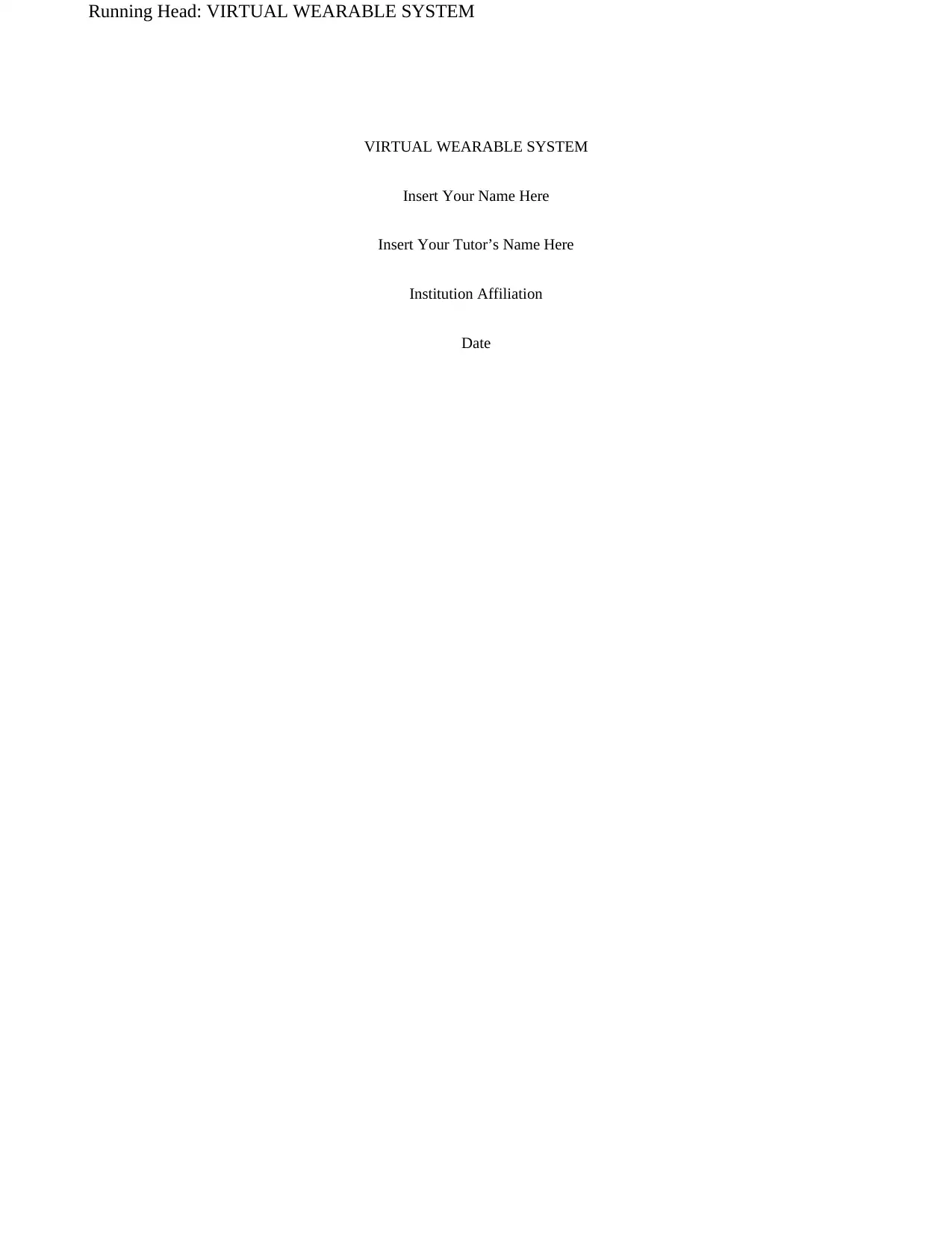
Running Head: VIRTUAL WEARABLE SYSTEM
VIRTUAL WEARABLE SYSTEM
Insert Your Name Here
Insert Your Tutor’s Name Here
Institution Affiliation
Date
VIRTUAL WEARABLE SYSTEM
Insert Your Name Here
Insert Your Tutor’s Name Here
Institution Affiliation
Date
Paraphrase This Document
Need a fresh take? Get an instant paraphrase of this document with our AI Paraphraser
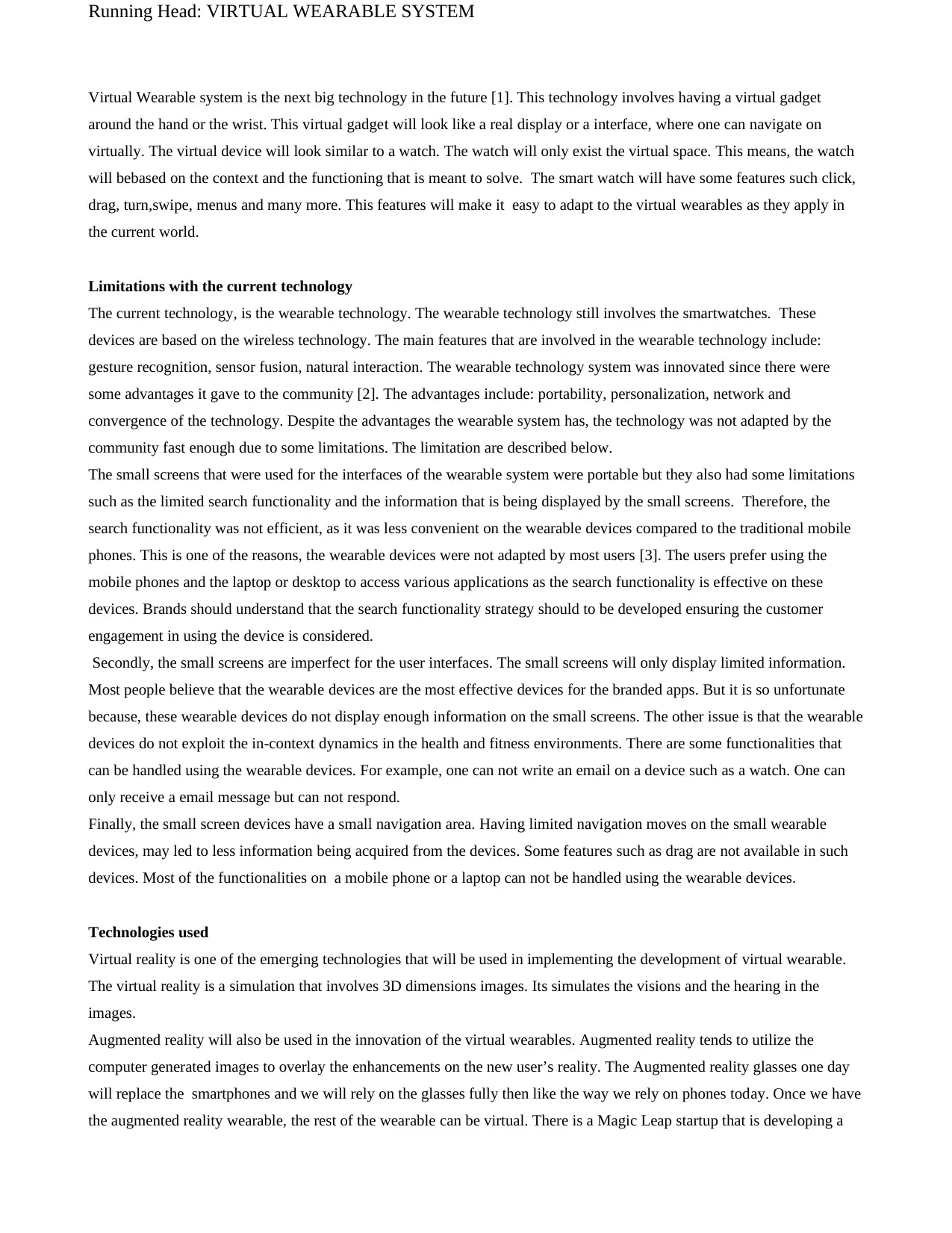
Running Head: VIRTUAL WEARABLE SYSTEM
Virtual Wearable system is the next big technology in the future [1]. This technology involves having a virtual gadget
around the hand or the wrist. This virtual gadget will look like a real display or a interface, where one can navigate on
virtually. The virtual device will look similar to a watch. The watch will only exist the virtual space. This means, the watch
will bebased on the context and the functioning that is meant to solve. The smart watch will have some features such click,
drag, turn,swipe, menus and many more. This features will make it easy to adapt to the virtual wearables as they apply in
the current world.
Limitations with the current technology
The current technology, is the wearable technology. The wearable technology still involves the smartwatches. These
devices are based on the wireless technology. The main features that are involved in the wearable technology include:
gesture recognition, sensor fusion, natural interaction. The wearable technology system was innovated since there were
some advantages it gave to the community [2]. The advantages include: portability, personalization, network and
convergence of the technology. Despite the advantages the wearable system has, the technology was not adapted by the
community fast enough due to some limitations. The limitation are described below.
The small screens that were used for the interfaces of the wearable system were portable but they also had some limitations
such as the limited search functionality and the information that is being displayed by the small screens. Therefore, the
search functionality was not efficient, as it was less convenient on the wearable devices compared to the traditional mobile
phones. This is one of the reasons, the wearable devices were not adapted by most users [3]. The users prefer using the
mobile phones and the laptop or desktop to access various applications as the search functionality is effective on these
devices. Brands should understand that the search functionality strategy should to be developed ensuring the customer
engagement in using the device is considered.
Secondly, the small screens are imperfect for the user interfaces. The small screens will only display limited information.
Most people believe that the wearable devices are the most effective devices for the branded apps. But it is so unfortunate
because, these wearable devices do not display enough information on the small screens. The other issue is that the wearable
devices do not exploit the in-context dynamics in the health and fitness environments. There are some functionalities that
can be handled using the wearable devices. For example, one can not write an email on a device such as a watch. One can
only receive a email message but can not respond.
Finally, the small screen devices have a small navigation area. Having limited navigation moves on the small wearable
devices, may led to less information being acquired from the devices. Some features such as drag are not available in such
devices. Most of the functionalities on a mobile phone or a laptop can not be handled using the wearable devices.
Technologies used
Virtual reality is one of the emerging technologies that will be used in implementing the development of virtual wearable.
The virtual reality is a simulation that involves 3D dimensions images. Its simulates the visions and the hearing in the
images.
Augmented reality will also be used in the innovation of the virtual wearables. Augmented reality tends to utilize the
computer generated images to overlay the enhancements on the new user’s reality. The Augmented reality glasses one day
will replace the smartphones and we will rely on the glasses fully then like the way we rely on phones today. Once we have
the augmented reality wearable, the rest of the wearable can be virtual. There is a Magic Leap startup that is developing a
Virtual Wearable system is the next big technology in the future [1]. This technology involves having a virtual gadget
around the hand or the wrist. This virtual gadget will look like a real display or a interface, where one can navigate on
virtually. The virtual device will look similar to a watch. The watch will only exist the virtual space. This means, the watch
will bebased on the context and the functioning that is meant to solve. The smart watch will have some features such click,
drag, turn,swipe, menus and many more. This features will make it easy to adapt to the virtual wearables as they apply in
the current world.
Limitations with the current technology
The current technology, is the wearable technology. The wearable technology still involves the smartwatches. These
devices are based on the wireless technology. The main features that are involved in the wearable technology include:
gesture recognition, sensor fusion, natural interaction. The wearable technology system was innovated since there were
some advantages it gave to the community [2]. The advantages include: portability, personalization, network and
convergence of the technology. Despite the advantages the wearable system has, the technology was not adapted by the
community fast enough due to some limitations. The limitation are described below.
The small screens that were used for the interfaces of the wearable system were portable but they also had some limitations
such as the limited search functionality and the information that is being displayed by the small screens. Therefore, the
search functionality was not efficient, as it was less convenient on the wearable devices compared to the traditional mobile
phones. This is one of the reasons, the wearable devices were not adapted by most users [3]. The users prefer using the
mobile phones and the laptop or desktop to access various applications as the search functionality is effective on these
devices. Brands should understand that the search functionality strategy should to be developed ensuring the customer
engagement in using the device is considered.
Secondly, the small screens are imperfect for the user interfaces. The small screens will only display limited information.
Most people believe that the wearable devices are the most effective devices for the branded apps. But it is so unfortunate
because, these wearable devices do not display enough information on the small screens. The other issue is that the wearable
devices do not exploit the in-context dynamics in the health and fitness environments. There are some functionalities that
can be handled using the wearable devices. For example, one can not write an email on a device such as a watch. One can
only receive a email message but can not respond.
Finally, the small screen devices have a small navigation area. Having limited navigation moves on the small wearable
devices, may led to less information being acquired from the devices. Some features such as drag are not available in such
devices. Most of the functionalities on a mobile phone or a laptop can not be handled using the wearable devices.
Technologies used
Virtual reality is one of the emerging technologies that will be used in implementing the development of virtual wearable.
The virtual reality is a simulation that involves 3D dimensions images. Its simulates the visions and the hearing in the
images.
Augmented reality will also be used in the innovation of the virtual wearables. Augmented reality tends to utilize the
computer generated images to overlay the enhancements on the new user’s reality. The Augmented reality glasses one day
will replace the smartphones and we will rely on the glasses fully then like the way we rely on phones today. Once we have
the augmented reality wearable, the rest of the wearable can be virtual. There is a Magic Leap startup that is developing a
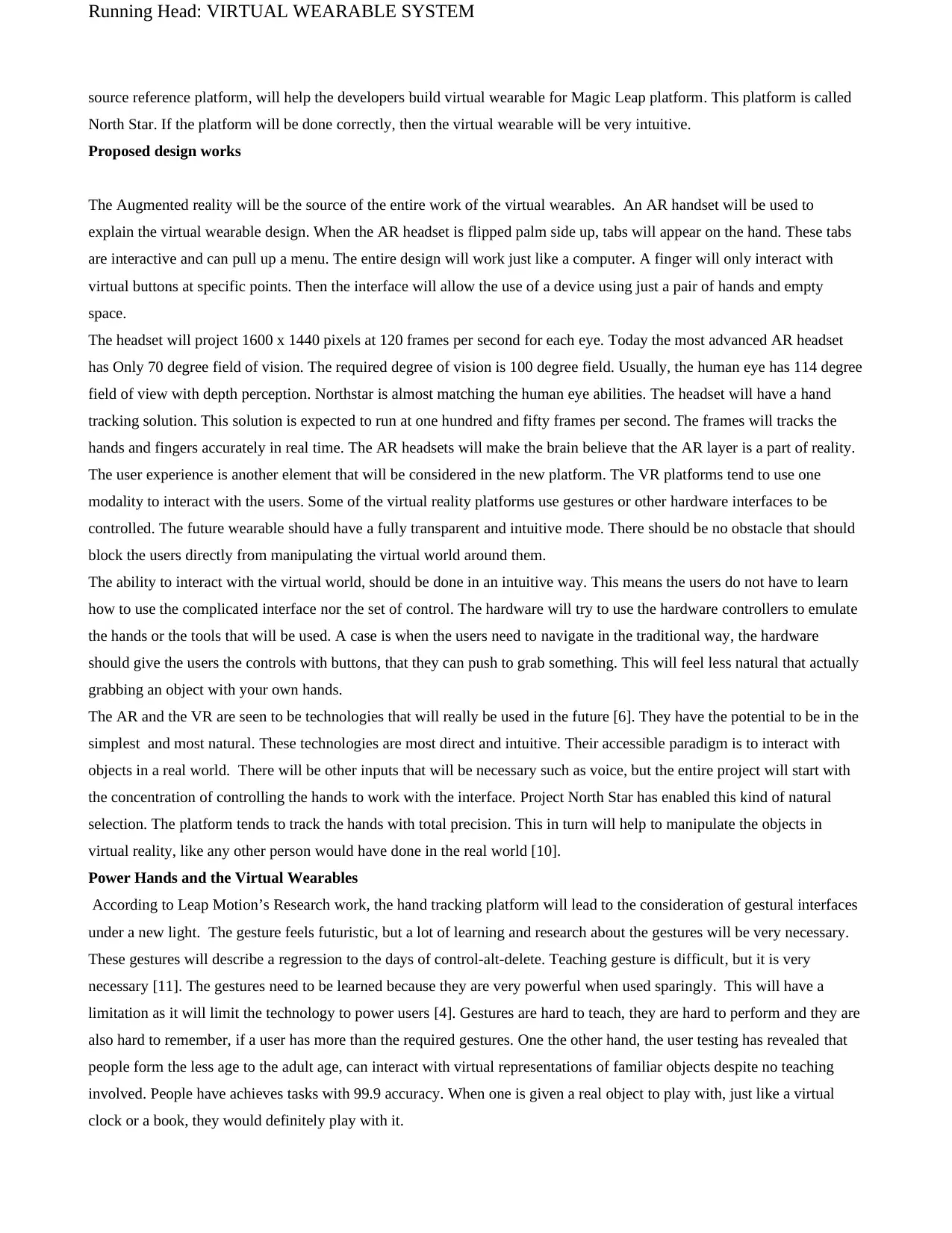
Running Head: VIRTUAL WEARABLE SYSTEM
source reference platform, will help the developers build virtual wearable for Magic Leap platform. This platform is called
North Star. If the platform will be done correctly, then the virtual wearable will be very intuitive.
Proposed design works
The Augmented reality will be the source of the entire work of the virtual wearables. An AR handset will be used to
explain the virtual wearable design. When the AR headset is flipped palm side up, tabs will appear on the hand. These tabs
are interactive and can pull up a menu. The entire design will work just like a computer. A finger will only interact with
virtual buttons at specific points. Then the interface will allow the use of a device using just a pair of hands and empty
space.
The headset will project 1600 x 1440 pixels at 120 frames per second for each eye. Today the most advanced AR headset
has Only 70 degree field of vision. The required degree of vision is 100 degree field. Usually, the human eye has 114 degree
field of view with depth perception. Northstar is almost matching the human eye abilities. The headset will have a hand
tracking solution. This solution is expected to run at one hundred and fifty frames per second. The frames will tracks the
hands and fingers accurately in real time. The AR headsets will make the brain believe that the AR layer is a part of reality.
The user experience is another element that will be considered in the new platform. The VR platforms tend to use one
modality to interact with the users. Some of the virtual reality platforms use gestures or other hardware interfaces to be
controlled. The future wearable should have a fully transparent and intuitive mode. There should be no obstacle that should
block the users directly from manipulating the virtual world around them.
The ability to interact with the virtual world, should be done in an intuitive way. This means the users do not have to learn
how to use the complicated interface nor the set of control. The hardware will try to use the hardware controllers to emulate
the hands or the tools that will be used. A case is when the users need to navigate in the traditional way, the hardware
should give the users the controls with buttons, that they can push to grab something. This will feel less natural that actually
grabbing an object with your own hands.
The AR and the VR are seen to be technologies that will really be used in the future [6]. They have the potential to be in the
simplest and most natural. These technologies are most direct and intuitive. Their accessible paradigm is to interact with
objects in a real world. There will be other inputs that will be necessary such as voice, but the entire project will start with
the concentration of controlling the hands to work with the interface. Project North Star has enabled this kind of natural
selection. The platform tends to track the hands with total precision. This in turn will help to manipulate the objects in
virtual reality, like any other person would have done in the real world [10].
Power Hands and the Virtual Wearables
According to Leap Motion’s Research work, the hand tracking platform will lead to the consideration of gestural interfaces
under a new light. The gesture feels futuristic, but a lot of learning and research about the gestures will be very necessary.
These gestures will describe a regression to the days of control-alt-delete. Teaching gesture is difficult, but it is very
necessary [11]. The gestures need to be learned because they are very powerful when used sparingly. This will have a
limitation as it will limit the technology to power users [4]. Gestures are hard to teach, they are hard to perform and they are
also hard to remember, if a user has more than the required gestures. One the other hand, the user testing has revealed that
people form the less age to the adult age, can interact with virtual representations of familiar objects despite no teaching
involved. People have achieves tasks with 99.9 accuracy. When one is given a real object to play with, just like a virtual
clock or a book, they would definitely play with it.
source reference platform, will help the developers build virtual wearable for Magic Leap platform. This platform is called
North Star. If the platform will be done correctly, then the virtual wearable will be very intuitive.
Proposed design works
The Augmented reality will be the source of the entire work of the virtual wearables. An AR handset will be used to
explain the virtual wearable design. When the AR headset is flipped palm side up, tabs will appear on the hand. These tabs
are interactive and can pull up a menu. The entire design will work just like a computer. A finger will only interact with
virtual buttons at specific points. Then the interface will allow the use of a device using just a pair of hands and empty
space.
The headset will project 1600 x 1440 pixels at 120 frames per second for each eye. Today the most advanced AR headset
has Only 70 degree field of vision. The required degree of vision is 100 degree field. Usually, the human eye has 114 degree
field of view with depth perception. Northstar is almost matching the human eye abilities. The headset will have a hand
tracking solution. This solution is expected to run at one hundred and fifty frames per second. The frames will tracks the
hands and fingers accurately in real time. The AR headsets will make the brain believe that the AR layer is a part of reality.
The user experience is another element that will be considered in the new platform. The VR platforms tend to use one
modality to interact with the users. Some of the virtual reality platforms use gestures or other hardware interfaces to be
controlled. The future wearable should have a fully transparent and intuitive mode. There should be no obstacle that should
block the users directly from manipulating the virtual world around them.
The ability to interact with the virtual world, should be done in an intuitive way. This means the users do not have to learn
how to use the complicated interface nor the set of control. The hardware will try to use the hardware controllers to emulate
the hands or the tools that will be used. A case is when the users need to navigate in the traditional way, the hardware
should give the users the controls with buttons, that they can push to grab something. This will feel less natural that actually
grabbing an object with your own hands.
The AR and the VR are seen to be technologies that will really be used in the future [6]. They have the potential to be in the
simplest and most natural. These technologies are most direct and intuitive. Their accessible paradigm is to interact with
objects in a real world. There will be other inputs that will be necessary such as voice, but the entire project will start with
the concentration of controlling the hands to work with the interface. Project North Star has enabled this kind of natural
selection. The platform tends to track the hands with total precision. This in turn will help to manipulate the objects in
virtual reality, like any other person would have done in the real world [10].
Power Hands and the Virtual Wearables
According to Leap Motion’s Research work, the hand tracking platform will lead to the consideration of gestural interfaces
under a new light. The gesture feels futuristic, but a lot of learning and research about the gestures will be very necessary.
These gestures will describe a regression to the days of control-alt-delete. Teaching gesture is difficult, but it is very
necessary [11]. The gestures need to be learned because they are very powerful when used sparingly. This will have a
limitation as it will limit the technology to power users [4]. Gestures are hard to teach, they are hard to perform and they are
also hard to remember, if a user has more than the required gestures. One the other hand, the user testing has revealed that
people form the less age to the adult age, can interact with virtual representations of familiar objects despite no teaching
involved. People have achieves tasks with 99.9 accuracy. When one is given a real object to play with, just like a virtual
clock or a book, they would definitely play with it.
⊘ This is a preview!⊘
Do you want full access?
Subscribe today to unlock all pages.

Trusted by 1+ million students worldwide
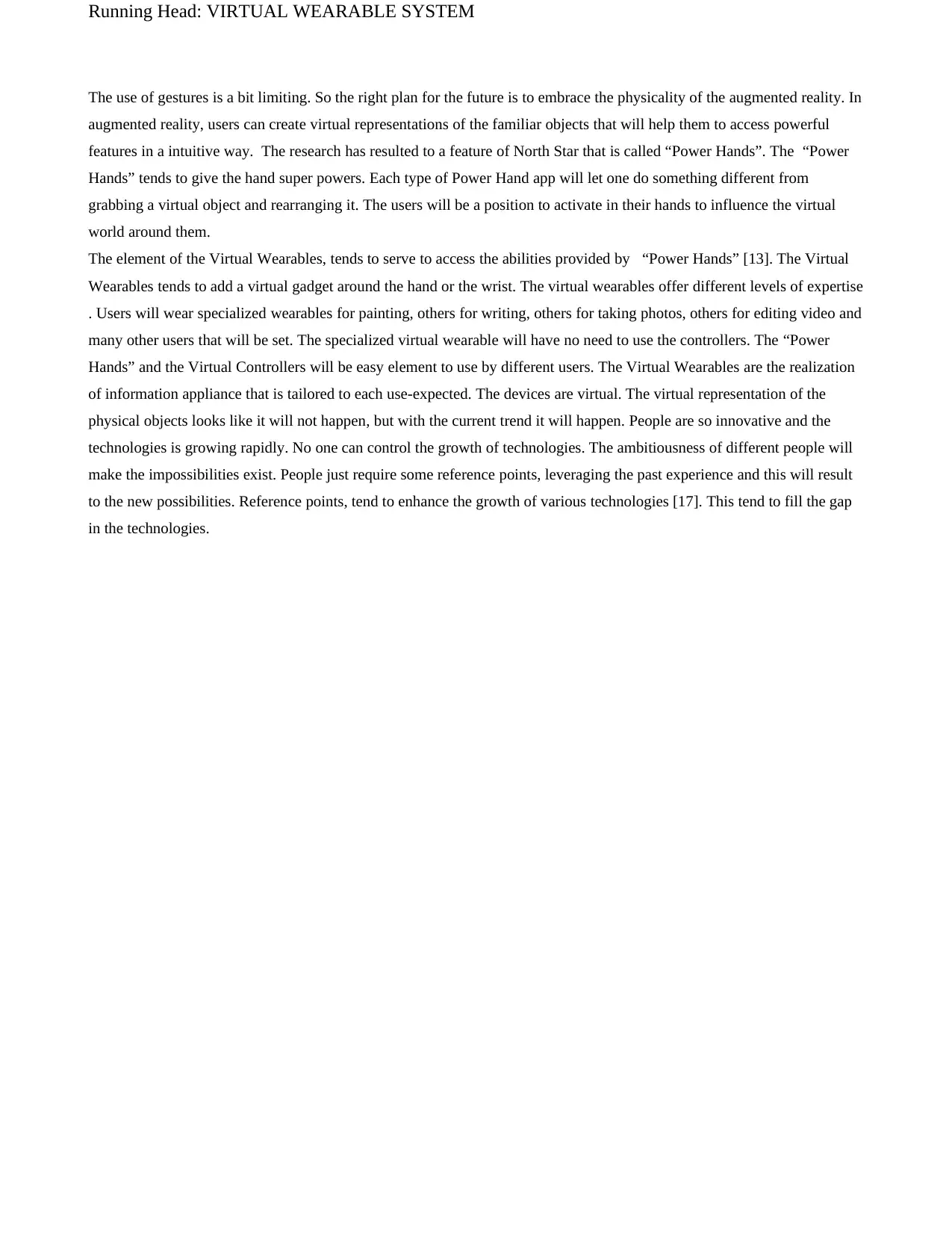
Running Head: VIRTUAL WEARABLE SYSTEM
The use of gestures is a bit limiting. So the right plan for the future is to embrace the physicality of the augmented reality. In
augmented reality, users can create virtual representations of the familiar objects that will help them to access powerful
features in a intuitive way. The research has resulted to a feature of North Star that is called “Power Hands”. The “Power
Hands” tends to give the hand super powers. Each type of Power Hand app will let one do something different from
grabbing a virtual object and rearranging it. The users will be a position to activate in their hands to influence the virtual
world around them.
The element of the Virtual Wearables, tends to serve to access the abilities provided by “Power Hands” [13]. The Virtual
Wearables tends to add a virtual gadget around the hand or the wrist. The virtual wearables offer different levels of expertise
. Users will wear specialized wearables for painting, others for writing, others for taking photos, others for editing video and
many other users that will be set. The specialized virtual wearable will have no need to use the controllers. The “Power
Hands” and the Virtual Controllers will be easy element to use by different users. The Virtual Wearables are the realization
of information appliance that is tailored to each use-expected. The devices are virtual. The virtual representation of the
physical objects looks like it will not happen, but with the current trend it will happen. People are so innovative and the
technologies is growing rapidly. No one can control the growth of technologies. The ambitiousness of different people will
make the impossibilities exist. People just require some reference points, leveraging the past experience and this will result
to the new possibilities. Reference points, tend to enhance the growth of various technologies [17]. This tend to fill the gap
in the technologies.
The use of gestures is a bit limiting. So the right plan for the future is to embrace the physicality of the augmented reality. In
augmented reality, users can create virtual representations of the familiar objects that will help them to access powerful
features in a intuitive way. The research has resulted to a feature of North Star that is called “Power Hands”. The “Power
Hands” tends to give the hand super powers. Each type of Power Hand app will let one do something different from
grabbing a virtual object and rearranging it. The users will be a position to activate in their hands to influence the virtual
world around them.
The element of the Virtual Wearables, tends to serve to access the abilities provided by “Power Hands” [13]. The Virtual
Wearables tends to add a virtual gadget around the hand or the wrist. The virtual wearables offer different levels of expertise
. Users will wear specialized wearables for painting, others for writing, others for taking photos, others for editing video and
many other users that will be set. The specialized virtual wearable will have no need to use the controllers. The “Power
Hands” and the Virtual Controllers will be easy element to use by different users. The Virtual Wearables are the realization
of information appliance that is tailored to each use-expected. The devices are virtual. The virtual representation of the
physical objects looks like it will not happen, but with the current trend it will happen. People are so innovative and the
technologies is growing rapidly. No one can control the growth of technologies. The ambitiousness of different people will
make the impossibilities exist. People just require some reference points, leveraging the past experience and this will result
to the new possibilities. Reference points, tend to enhance the growth of various technologies [17]. This tend to fill the gap
in the technologies.
Paraphrase This Document
Need a fresh take? Get an instant paraphrase of this document with our AI Paraphraser
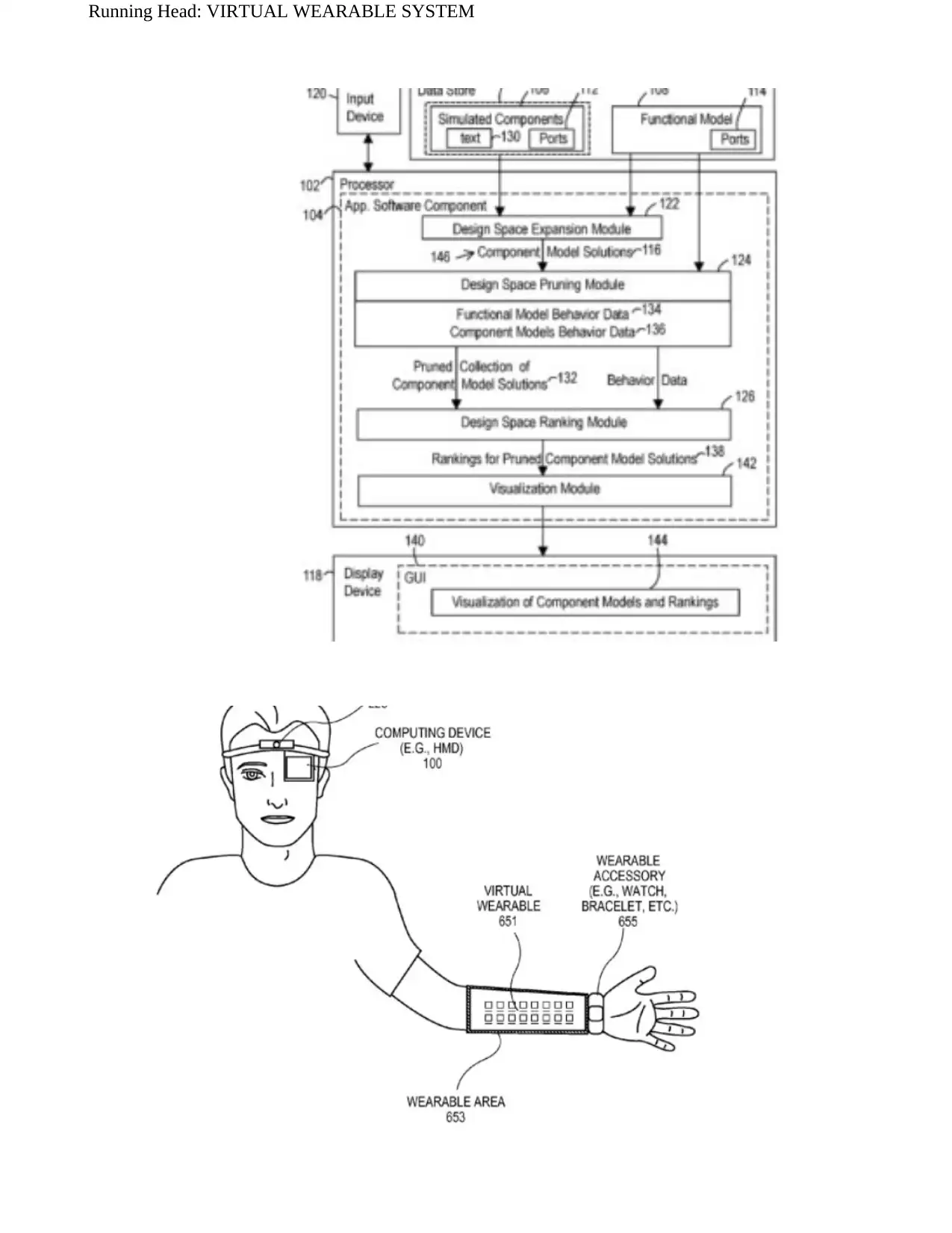
Running Head: VIRTUAL WEARABLE SYSTEM
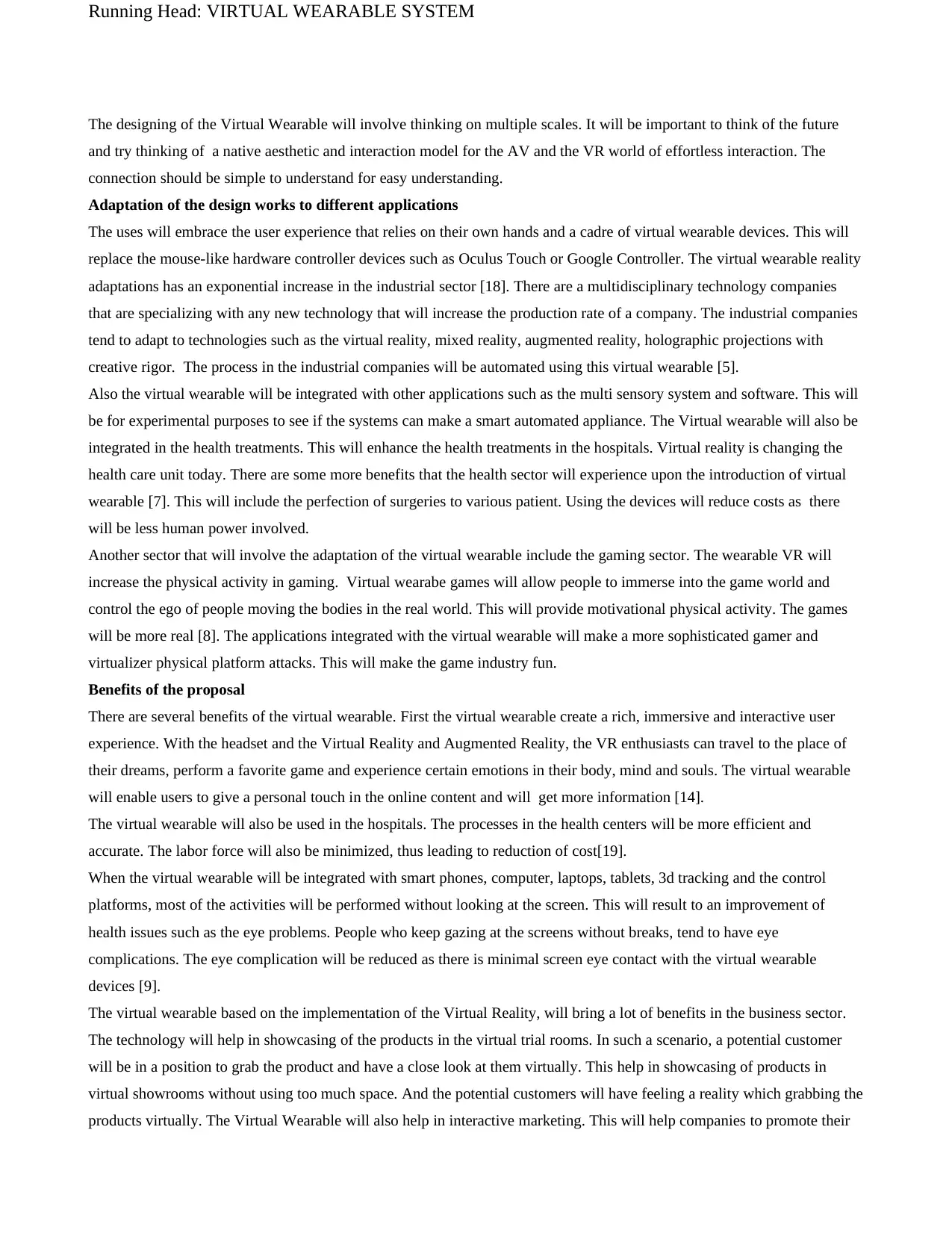
Running Head: VIRTUAL WEARABLE SYSTEM
The designing of the Virtual Wearable will involve thinking on multiple scales. It will be important to think of the future
and try thinking of a native aesthetic and interaction model for the AV and the VR world of effortless interaction. The
connection should be simple to understand for easy understanding.
Adaptation of the design works to different applications
The uses will embrace the user experience that relies on their own hands and a cadre of virtual wearable devices. This will
replace the mouse-like hardware controller devices such as Oculus Touch or Google Controller. The virtual wearable reality
adaptations has an exponential increase in the industrial sector [18]. There are a multidisciplinary technology companies
that are specializing with any new technology that will increase the production rate of a company. The industrial companies
tend to adapt to technologies such as the virtual reality, mixed reality, augmented reality, holographic projections with
creative rigor. The process in the industrial companies will be automated using this virtual wearable [5].
Also the virtual wearable will be integrated with other applications such as the multi sensory system and software. This will
be for experimental purposes to see if the systems can make a smart automated appliance. The Virtual wearable will also be
integrated in the health treatments. This will enhance the health treatments in the hospitals. Virtual reality is changing the
health care unit today. There are some more benefits that the health sector will experience upon the introduction of virtual
wearable [7]. This will include the perfection of surgeries to various patient. Using the devices will reduce costs as there
will be less human power involved.
Another sector that will involve the adaptation of the virtual wearable include the gaming sector. The wearable VR will
increase the physical activity in gaming. Virtual wearabe games will allow people to immerse into the game world and
control the ego of people moving the bodies in the real world. This will provide motivational physical activity. The games
will be more real [8]. The applications integrated with the virtual wearable will make a more sophisticated gamer and
virtualizer physical platform attacks. This will make the game industry fun.
Benefits of the proposal
There are several benefits of the virtual wearable. First the virtual wearable create a rich, immersive and interactive user
experience. With the headset and the Virtual Reality and Augmented Reality, the VR enthusiasts can travel to the place of
their dreams, perform a favorite game and experience certain emotions in their body, mind and souls. The virtual wearable
will enable users to give a personal touch in the online content and will get more information [14].
The virtual wearable will also be used in the hospitals. The processes in the health centers will be more efficient and
accurate. The labor force will also be minimized, thus leading to reduction of cost[19].
When the virtual wearable will be integrated with smart phones, computer, laptops, tablets, 3d tracking and the control
platforms, most of the activities will be performed without looking at the screen. This will result to an improvement of
health issues such as the eye problems. People who keep gazing at the screens without breaks, tend to have eye
complications. The eye complication will be reduced as there is minimal screen eye contact with the virtual wearable
devices [9].
The virtual wearable based on the implementation of the Virtual Reality, will bring a lot of benefits in the business sector.
The technology will help in showcasing of the products in the virtual trial rooms. In such a scenario, a potential customer
will be in a position to grab the product and have a close look at them virtually. This help in showcasing of products in
virtual showrooms without using too much space. And the potential customers will have feeling a reality which grabbing the
products virtually. The Virtual Wearable will also help in interactive marketing. This will help companies to promote their
The designing of the Virtual Wearable will involve thinking on multiple scales. It will be important to think of the future
and try thinking of a native aesthetic and interaction model for the AV and the VR world of effortless interaction. The
connection should be simple to understand for easy understanding.
Adaptation of the design works to different applications
The uses will embrace the user experience that relies on their own hands and a cadre of virtual wearable devices. This will
replace the mouse-like hardware controller devices such as Oculus Touch or Google Controller. The virtual wearable reality
adaptations has an exponential increase in the industrial sector [18]. There are a multidisciplinary technology companies
that are specializing with any new technology that will increase the production rate of a company. The industrial companies
tend to adapt to technologies such as the virtual reality, mixed reality, augmented reality, holographic projections with
creative rigor. The process in the industrial companies will be automated using this virtual wearable [5].
Also the virtual wearable will be integrated with other applications such as the multi sensory system and software. This will
be for experimental purposes to see if the systems can make a smart automated appliance. The Virtual wearable will also be
integrated in the health treatments. This will enhance the health treatments in the hospitals. Virtual reality is changing the
health care unit today. There are some more benefits that the health sector will experience upon the introduction of virtual
wearable [7]. This will include the perfection of surgeries to various patient. Using the devices will reduce costs as there
will be less human power involved.
Another sector that will involve the adaptation of the virtual wearable include the gaming sector. The wearable VR will
increase the physical activity in gaming. Virtual wearabe games will allow people to immerse into the game world and
control the ego of people moving the bodies in the real world. This will provide motivational physical activity. The games
will be more real [8]. The applications integrated with the virtual wearable will make a more sophisticated gamer and
virtualizer physical platform attacks. This will make the game industry fun.
Benefits of the proposal
There are several benefits of the virtual wearable. First the virtual wearable create a rich, immersive and interactive user
experience. With the headset and the Virtual Reality and Augmented Reality, the VR enthusiasts can travel to the place of
their dreams, perform a favorite game and experience certain emotions in their body, mind and souls. The virtual wearable
will enable users to give a personal touch in the online content and will get more information [14].
The virtual wearable will also be used in the hospitals. The processes in the health centers will be more efficient and
accurate. The labor force will also be minimized, thus leading to reduction of cost[19].
When the virtual wearable will be integrated with smart phones, computer, laptops, tablets, 3d tracking and the control
platforms, most of the activities will be performed without looking at the screen. This will result to an improvement of
health issues such as the eye problems. People who keep gazing at the screens without breaks, tend to have eye
complications. The eye complication will be reduced as there is minimal screen eye contact with the virtual wearable
devices [9].
The virtual wearable based on the implementation of the Virtual Reality, will bring a lot of benefits in the business sector.
The technology will help in showcasing of the products in the virtual trial rooms. In such a scenario, a potential customer
will be in a position to grab the product and have a close look at them virtually. This help in showcasing of products in
virtual showrooms without using too much space. And the potential customers will have feeling a reality which grabbing the
products virtually. The Virtual Wearable will also help in interactive marketing. This will help companies to promote their
⊘ This is a preview!⊘
Do you want full access?
Subscribe today to unlock all pages.

Trusted by 1+ million students worldwide
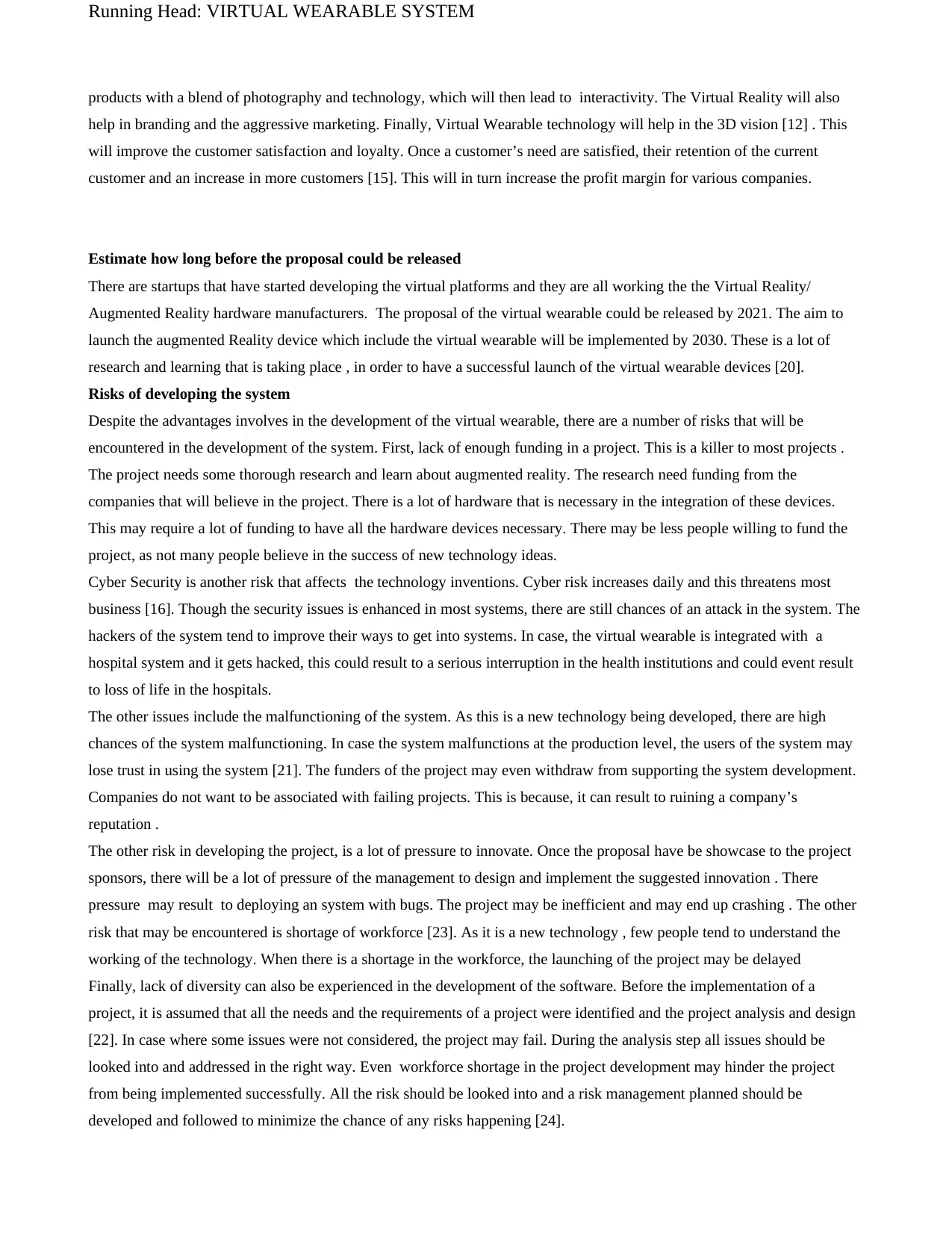
Running Head: VIRTUAL WEARABLE SYSTEM
products with a blend of photography and technology, which will then lead to interactivity. The Virtual Reality will also
help in branding and the aggressive marketing. Finally, Virtual Wearable technology will help in the 3D vision [12] . This
will improve the customer satisfaction and loyalty. Once a customer’s need are satisfied, their retention of the current
customer and an increase in more customers [15]. This will in turn increase the profit margin for various companies.
Estimate how long before the proposal could be released
There are startups that have started developing the virtual platforms and they are all working the the Virtual Reality/
Augmented Reality hardware manufacturers. The proposal of the virtual wearable could be released by 2021. The aim to
launch the augmented Reality device which include the virtual wearable will be implemented by 2030. These is a lot of
research and learning that is taking place , in order to have a successful launch of the virtual wearable devices [20].
Risks of developing the system
Despite the advantages involves in the development of the virtual wearable, there are a number of risks that will be
encountered in the development of the system. First, lack of enough funding in a project. This is a killer to most projects .
The project needs some thorough research and learn about augmented reality. The research need funding from the
companies that will believe in the project. There is a lot of hardware that is necessary in the integration of these devices.
This may require a lot of funding to have all the hardware devices necessary. There may be less people willing to fund the
project, as not many people believe in the success of new technology ideas.
Cyber Security is another risk that affects the technology inventions. Cyber risk increases daily and this threatens most
business [16]. Though the security issues is enhanced in most systems, there are still chances of an attack in the system. The
hackers of the system tend to improve their ways to get into systems. In case, the virtual wearable is integrated with a
hospital system and it gets hacked, this could result to a serious interruption in the health institutions and could event result
to loss of life in the hospitals.
The other issues include the malfunctioning of the system. As this is a new technology being developed, there are high
chances of the system malfunctioning. In case the system malfunctions at the production level, the users of the system may
lose trust in using the system [21]. The funders of the project may even withdraw from supporting the system development.
Companies do not want to be associated with failing projects. This is because, it can result to ruining a company’s
reputation .
The other risk in developing the project, is a lot of pressure to innovate. Once the proposal have be showcase to the project
sponsors, there will be a lot of pressure of the management to design and implement the suggested innovation . There
pressure may result to deploying an system with bugs. The project may be inefficient and may end up crashing . The other
risk that may be encountered is shortage of workforce [23]. As it is a new technology , few people tend to understand the
working of the technology. When there is a shortage in the workforce, the launching of the project may be delayed
Finally, lack of diversity can also be experienced in the development of the software. Before the implementation of a
project, it is assumed that all the needs and the requirements of a project were identified and the project analysis and design
[22]. In case where some issues were not considered, the project may fail. During the analysis step all issues should be
looked into and addressed in the right way. Even workforce shortage in the project development may hinder the project
from being implemented successfully. All the risk should be looked into and a risk management planned should be
developed and followed to minimize the chance of any risks happening [24].
products with a blend of photography and technology, which will then lead to interactivity. The Virtual Reality will also
help in branding and the aggressive marketing. Finally, Virtual Wearable technology will help in the 3D vision [12] . This
will improve the customer satisfaction and loyalty. Once a customer’s need are satisfied, their retention of the current
customer and an increase in more customers [15]. This will in turn increase the profit margin for various companies.
Estimate how long before the proposal could be released
There are startups that have started developing the virtual platforms and they are all working the the Virtual Reality/
Augmented Reality hardware manufacturers. The proposal of the virtual wearable could be released by 2021. The aim to
launch the augmented Reality device which include the virtual wearable will be implemented by 2030. These is a lot of
research and learning that is taking place , in order to have a successful launch of the virtual wearable devices [20].
Risks of developing the system
Despite the advantages involves in the development of the virtual wearable, there are a number of risks that will be
encountered in the development of the system. First, lack of enough funding in a project. This is a killer to most projects .
The project needs some thorough research and learn about augmented reality. The research need funding from the
companies that will believe in the project. There is a lot of hardware that is necessary in the integration of these devices.
This may require a lot of funding to have all the hardware devices necessary. There may be less people willing to fund the
project, as not many people believe in the success of new technology ideas.
Cyber Security is another risk that affects the technology inventions. Cyber risk increases daily and this threatens most
business [16]. Though the security issues is enhanced in most systems, there are still chances of an attack in the system. The
hackers of the system tend to improve their ways to get into systems. In case, the virtual wearable is integrated with a
hospital system and it gets hacked, this could result to a serious interruption in the health institutions and could event result
to loss of life in the hospitals.
The other issues include the malfunctioning of the system. As this is a new technology being developed, there are high
chances of the system malfunctioning. In case the system malfunctions at the production level, the users of the system may
lose trust in using the system [21]. The funders of the project may even withdraw from supporting the system development.
Companies do not want to be associated with failing projects. This is because, it can result to ruining a company’s
reputation .
The other risk in developing the project, is a lot of pressure to innovate. Once the proposal have be showcase to the project
sponsors, there will be a lot of pressure of the management to design and implement the suggested innovation . There
pressure may result to deploying an system with bugs. The project may be inefficient and may end up crashing . The other
risk that may be encountered is shortage of workforce [23]. As it is a new technology , few people tend to understand the
working of the technology. When there is a shortage in the workforce, the launching of the project may be delayed
Finally, lack of diversity can also be experienced in the development of the software. Before the implementation of a
project, it is assumed that all the needs and the requirements of a project were identified and the project analysis and design
[22]. In case where some issues were not considered, the project may fail. During the analysis step all issues should be
looked into and addressed in the right way. Even workforce shortage in the project development may hinder the project
from being implemented successfully. All the risk should be looked into and a risk management planned should be
developed and followed to minimize the chance of any risks happening [24].
Paraphrase This Document
Need a fresh take? Get an instant paraphrase of this document with our AI Paraphraser

Running Head: VIRTUAL WEARABLE SYSTEM
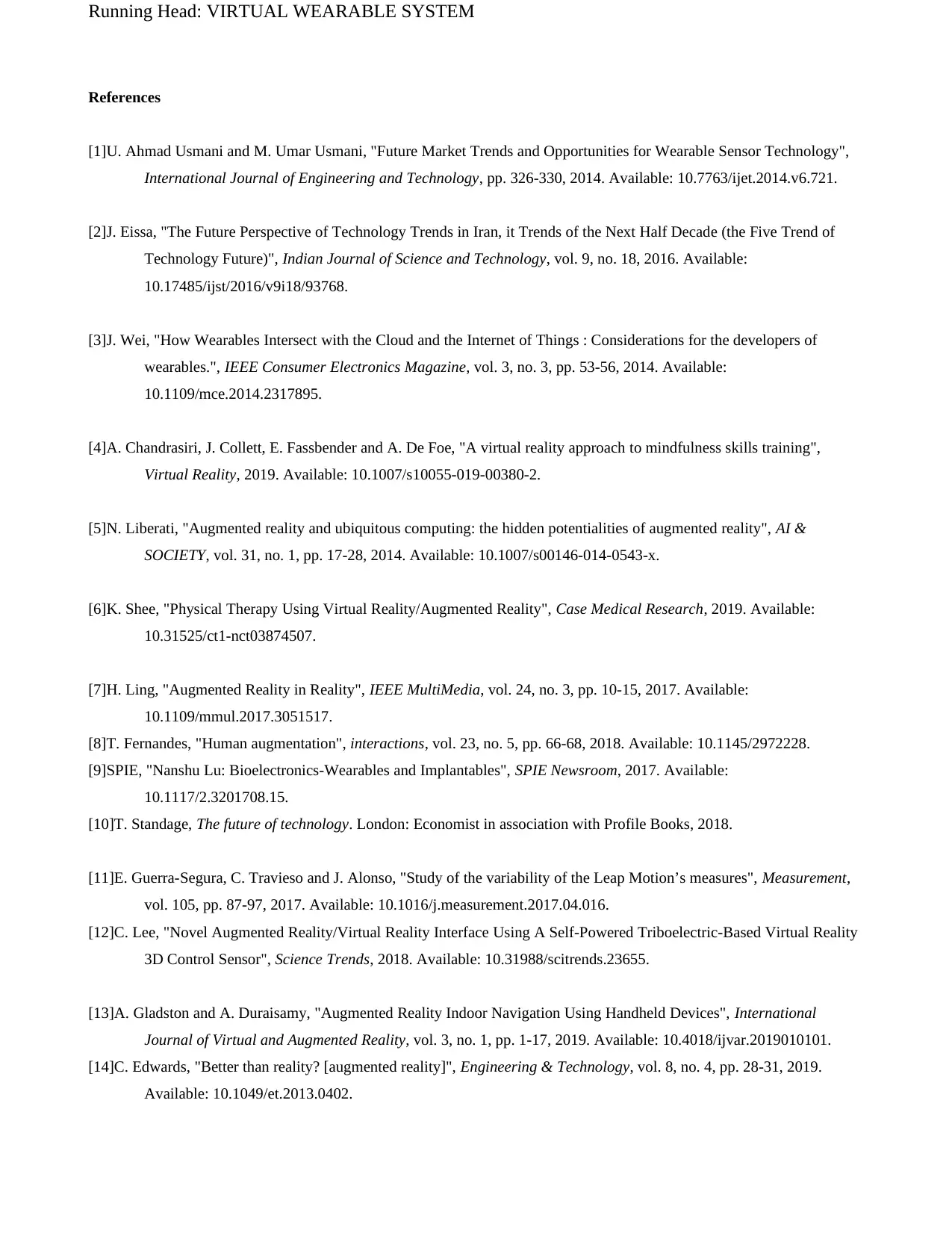
Running Head: VIRTUAL WEARABLE SYSTEM
References
[1]U. Ahmad Usmani and M. Umar Usmani, "Future Market Trends and Opportunities for Wearable Sensor Technology",
International Journal of Engineering and Technology, pp. 326-330, 2014. Available: 10.7763/ijet.2014.v6.721.
[2]J. Eissa, "The Future Perspective of Technology Trends in Iran, it Trends of the Next Half Decade (the Five Trend of
Technology Future)", Indian Journal of Science and Technology, vol. 9, no. 18, 2016. Available:
10.17485/ijst/2016/v9i18/93768.
[3]J. Wei, "How Wearables Intersect with the Cloud and the Internet of Things : Considerations for the developers of
wearables.", IEEE Consumer Electronics Magazine, vol. 3, no. 3, pp. 53-56, 2014. Available:
10.1109/mce.2014.2317895.
[4]A. Chandrasiri, J. Collett, E. Fassbender and A. De Foe, "A virtual reality approach to mindfulness skills training",
Virtual Reality, 2019. Available: 10.1007/s10055-019-00380-2.
[5]N. Liberati, "Augmented reality and ubiquitous computing: the hidden potentialities of augmented reality", AI &
SOCIETY, vol. 31, no. 1, pp. 17-28, 2014. Available: 10.1007/s00146-014-0543-x.
[6]K. Shee, "Physical Therapy Using Virtual Reality/Augmented Reality", Case Medical Research, 2019. Available:
10.31525/ct1-nct03874507.
[7]H. Ling, "Augmented Reality in Reality", IEEE MultiMedia, vol. 24, no. 3, pp. 10-15, 2017. Available:
10.1109/mmul.2017.3051517.
[8]T. Fernandes, "Human augmentation", interactions, vol. 23, no. 5, pp. 66-68, 2018. Available: 10.1145/2972228.
[9]SPIE, "Nanshu Lu: Bioelectronics-Wearables and Implantables", SPIE Newsroom, 2017. Available:
10.1117/2.3201708.15.
[10]T. Standage, The future of technology. London: Economist in association with Profile Books, 2018.
[11]E. Guerra-Segura, C. Travieso and J. Alonso, "Study of the variability of the Leap Motion’s measures", Measurement,
vol. 105, pp. 87-97, 2017. Available: 10.1016/j.measurement.2017.04.016.
[12]C. Lee, "Novel Augmented Reality/Virtual Reality Interface Using A Self-Powered Triboelectric-Based Virtual Reality
3D Control Sensor", Science Trends, 2018. Available: 10.31988/scitrends.23655.
[13]A. Gladston and A. Duraisamy, "Augmented Reality Indoor Navigation Using Handheld Devices", International
Journal of Virtual and Augmented Reality, vol. 3, no. 1, pp. 1-17, 2019. Available: 10.4018/ijvar.2019010101.
[14]C. Edwards, "Better than reality? [augmented reality]", Engineering & Technology, vol. 8, no. 4, pp. 28-31, 2019.
Available: 10.1049/et.2013.0402.
References
[1]U. Ahmad Usmani and M. Umar Usmani, "Future Market Trends and Opportunities for Wearable Sensor Technology",
International Journal of Engineering and Technology, pp. 326-330, 2014. Available: 10.7763/ijet.2014.v6.721.
[2]J. Eissa, "The Future Perspective of Technology Trends in Iran, it Trends of the Next Half Decade (the Five Trend of
Technology Future)", Indian Journal of Science and Technology, vol. 9, no. 18, 2016. Available:
10.17485/ijst/2016/v9i18/93768.
[3]J. Wei, "How Wearables Intersect with the Cloud and the Internet of Things : Considerations for the developers of
wearables.", IEEE Consumer Electronics Magazine, vol. 3, no. 3, pp. 53-56, 2014. Available:
10.1109/mce.2014.2317895.
[4]A. Chandrasiri, J. Collett, E. Fassbender and A. De Foe, "A virtual reality approach to mindfulness skills training",
Virtual Reality, 2019. Available: 10.1007/s10055-019-00380-2.
[5]N. Liberati, "Augmented reality and ubiquitous computing: the hidden potentialities of augmented reality", AI &
SOCIETY, vol. 31, no. 1, pp. 17-28, 2014. Available: 10.1007/s00146-014-0543-x.
[6]K. Shee, "Physical Therapy Using Virtual Reality/Augmented Reality", Case Medical Research, 2019. Available:
10.31525/ct1-nct03874507.
[7]H. Ling, "Augmented Reality in Reality", IEEE MultiMedia, vol. 24, no. 3, pp. 10-15, 2017. Available:
10.1109/mmul.2017.3051517.
[8]T. Fernandes, "Human augmentation", interactions, vol. 23, no. 5, pp. 66-68, 2018. Available: 10.1145/2972228.
[9]SPIE, "Nanshu Lu: Bioelectronics-Wearables and Implantables", SPIE Newsroom, 2017. Available:
10.1117/2.3201708.15.
[10]T. Standage, The future of technology. London: Economist in association with Profile Books, 2018.
[11]E. Guerra-Segura, C. Travieso and J. Alonso, "Study of the variability of the Leap Motion’s measures", Measurement,
vol. 105, pp. 87-97, 2017. Available: 10.1016/j.measurement.2017.04.016.
[12]C. Lee, "Novel Augmented Reality/Virtual Reality Interface Using A Self-Powered Triboelectric-Based Virtual Reality
3D Control Sensor", Science Trends, 2018. Available: 10.31988/scitrends.23655.
[13]A. Gladston and A. Duraisamy, "Augmented Reality Indoor Navigation Using Handheld Devices", International
Journal of Virtual and Augmented Reality, vol. 3, no. 1, pp. 1-17, 2019. Available: 10.4018/ijvar.2019010101.
[14]C. Edwards, "Better than reality? [augmented reality]", Engineering & Technology, vol. 8, no. 4, pp. 28-31, 2019.
Available: 10.1049/et.2013.0402.
⊘ This is a preview!⊘
Do you want full access?
Subscribe today to unlock all pages.

Trusted by 1+ million students worldwide
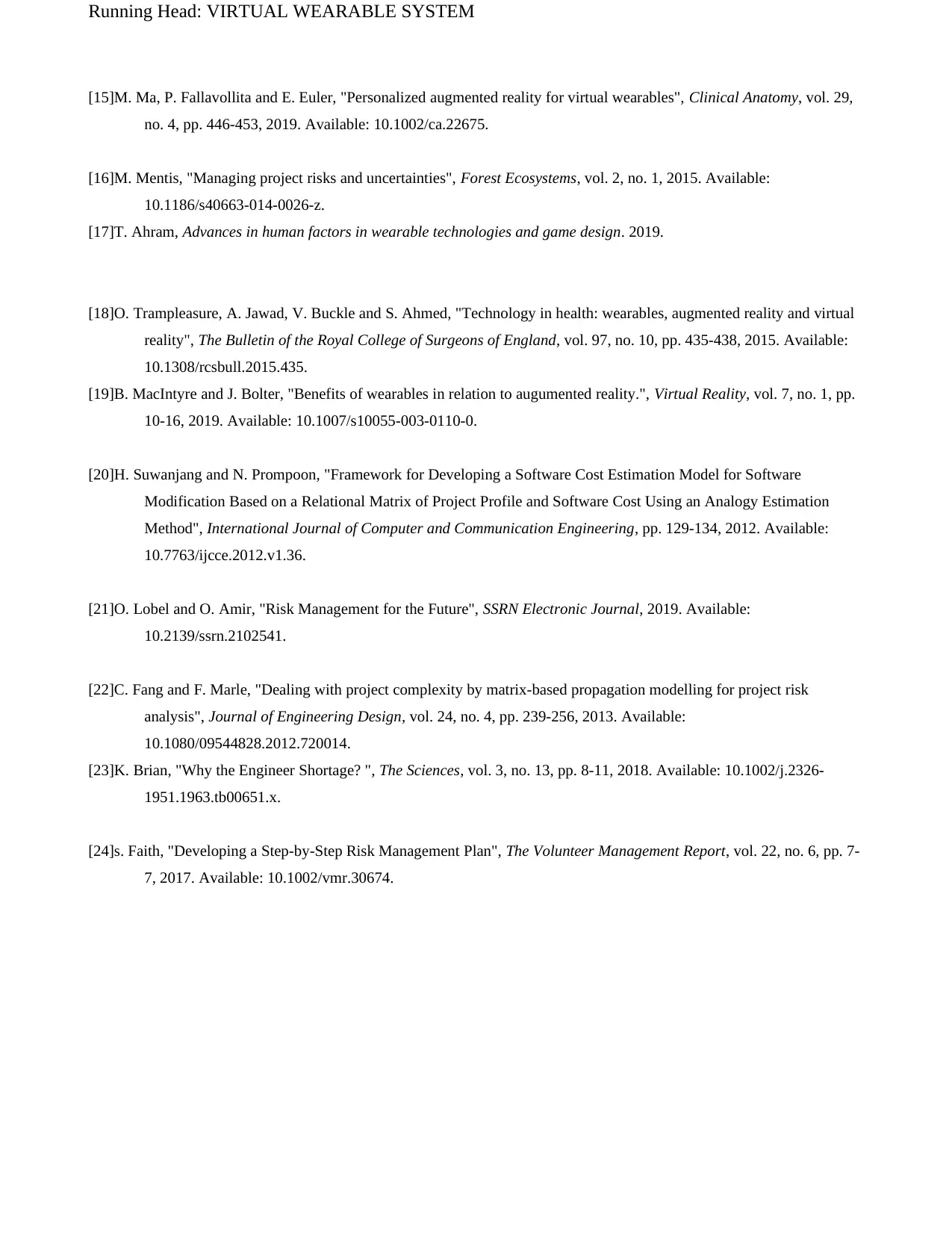
Running Head: VIRTUAL WEARABLE SYSTEM
[15]M. Ma, P. Fallavollita and E. Euler, "Personalized augmented reality for virtual wearables", Clinical Anatomy, vol. 29,
no. 4, pp. 446-453, 2019. Available: 10.1002/ca.22675.
[16]M. Mentis, "Managing project risks and uncertainties", Forest Ecosystems, vol. 2, no. 1, 2015. Available:
10.1186/s40663-014-0026-z.
[17]T. Ahram, Advances in human factors in wearable technologies and game design. 2019.
[18]O. Trampleasure, A. Jawad, V. Buckle and S. Ahmed, "Technology in health: wearables, augmented reality and virtual
reality", The Bulletin of the Royal College of Surgeons of England, vol. 97, no. 10, pp. 435-438, 2015. Available:
10.1308/rcsbull.2015.435.
[19]B. MacIntyre and J. Bolter, "Benefits of wearables in relation to augumented reality.", Virtual Reality, vol. 7, no. 1, pp.
10-16, 2019. Available: 10.1007/s10055-003-0110-0.
[20]H. Suwanjang and N. Prompoon, "Framework for Developing a Software Cost Estimation Model for Software
Modification Based on a Relational Matrix of Project Profile and Software Cost Using an Analogy Estimation
Method", International Journal of Computer and Communication Engineering, pp. 129-134, 2012. Available:
10.7763/ijcce.2012.v1.36.
[21]O. Lobel and O. Amir, "Risk Management for the Future", SSRN Electronic Journal, 2019. Available:
10.2139/ssrn.2102541.
[22]C. Fang and F. Marle, "Dealing with project complexity by matrix-based propagation modelling for project risk
analysis", Journal of Engineering Design, vol. 24, no. 4, pp. 239-256, 2013. Available:
10.1080/09544828.2012.720014.
[23]K. Brian, "Why the Engineer Shortage? ", The Sciences, vol. 3, no. 13, pp. 8-11, 2018. Available: 10.1002/j.2326-
1951.1963.tb00651.x.
[24]s. Faith, "Developing a Step-by-Step Risk Management Plan", The Volunteer Management Report, vol. 22, no. 6, pp. 7-
7, 2017. Available: 10.1002/vmr.30674.
[15]M. Ma, P. Fallavollita and E. Euler, "Personalized augmented reality for virtual wearables", Clinical Anatomy, vol. 29,
no. 4, pp. 446-453, 2019. Available: 10.1002/ca.22675.
[16]M. Mentis, "Managing project risks and uncertainties", Forest Ecosystems, vol. 2, no. 1, 2015. Available:
10.1186/s40663-014-0026-z.
[17]T. Ahram, Advances in human factors in wearable technologies and game design. 2019.
[18]O. Trampleasure, A. Jawad, V. Buckle and S. Ahmed, "Technology in health: wearables, augmented reality and virtual
reality", The Bulletin of the Royal College of Surgeons of England, vol. 97, no. 10, pp. 435-438, 2015. Available:
10.1308/rcsbull.2015.435.
[19]B. MacIntyre and J. Bolter, "Benefits of wearables in relation to augumented reality.", Virtual Reality, vol. 7, no. 1, pp.
10-16, 2019. Available: 10.1007/s10055-003-0110-0.
[20]H. Suwanjang and N. Prompoon, "Framework for Developing a Software Cost Estimation Model for Software
Modification Based on a Relational Matrix of Project Profile and Software Cost Using an Analogy Estimation
Method", International Journal of Computer and Communication Engineering, pp. 129-134, 2012. Available:
10.7763/ijcce.2012.v1.36.
[21]O. Lobel and O. Amir, "Risk Management for the Future", SSRN Electronic Journal, 2019. Available:
10.2139/ssrn.2102541.
[22]C. Fang and F. Marle, "Dealing with project complexity by matrix-based propagation modelling for project risk
analysis", Journal of Engineering Design, vol. 24, no. 4, pp. 239-256, 2013. Available:
10.1080/09544828.2012.720014.
[23]K. Brian, "Why the Engineer Shortage? ", The Sciences, vol. 3, no. 13, pp. 8-11, 2018. Available: 10.1002/j.2326-
1951.1963.tb00651.x.
[24]s. Faith, "Developing a Step-by-Step Risk Management Plan", The Volunteer Management Report, vol. 22, no. 6, pp. 7-
7, 2017. Available: 10.1002/vmr.30674.
1 out of 10
Related Documents
Your All-in-One AI-Powered Toolkit for Academic Success.
+13062052269
info@desklib.com
Available 24*7 on WhatsApp / Email
![[object Object]](/_next/static/media/star-bottom.7253800d.svg)
Unlock your academic potential
Copyright © 2020–2025 A2Z Services. All Rights Reserved. Developed and managed by ZUCOL.





